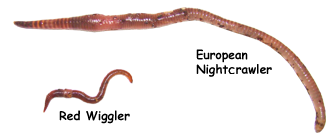Red Wiggler Worms - Reliable Decomposers for Your Garden Compost Bin
Wiki Article
Red Wiggler Worms Demystified: Opening the Keys of Vermiculture for Greener Living and Nutrient-Rich Dirt
In the realm of lasting practices for enhancing soil top quality and promoting eco-conscious living, red wiggler worms play an essential yet often ignored duty. These modest animals possess the remarkable ability to change organic waste into nutrient-rich castings that act as a powerful natural plant food. By delving right into the globe of vermiculture, one can discover a plethora of advantages that prolong far past traditional composting approaches. Understanding the complexities of taking care of these worms, optimizing their environment, and utilizing their castings can bring about a greener lifestyle and healthier soil for plants to grow.The Function of Red Wiggler Worms
Red Wiggler worms play an important duty in composting systems by effectively damaging down organic issue right into nutrient-rich spreadings. These starved eaters consume a selection of natural products, such as cooking area scraps, yard waste, and paper products. As they feed, the worms' digestion processes break down the raw material into a fine, dark, and nutrient-dense material called worm spreadings or vermicompost.The spreadings generated by Red Wiggler worms are very valuable for soil health and wellness and plant development. They are abundant in essential nutrients like nitrogen, potassium, and phosphorus, which are important for sustaining healthy plant growth. In addition, worm spreadings contain helpful microorganisms and enzymes that help improve soil framework, rise water retention, and boost nutrient uptake by plants.
Benefits of Vermicomposting

It improves soil framework, improves dirt oygenation, and raises soil dampness retention. Vermicompost also enhances the dirt with crucial nutrients like phosphorus, potassium, and nitrogen, promoting plant growth and total dirt fertility.
Additionally, vermicomposting supports sustainable horticulture practices by offering a all-natural and chemical-free alternative to synthetic plant foods. Red Wiggler Worms. This eco-friendly technique not just enriches the soil but additionally helps decrease reliance on unsafe chemicals, advertising a greener and more sustainable means of gardening
Establishing a Worm Bin
When establishing a worm bin for vermicomposting, appropriate arrangement is critical to ensure the success of the composting process. The primary step in establishing a worm container is choosing an appropriate container. This can be a plastic container or wooden box that provides enough space for the worms to walk around and has correct drain holes to stop waterlogging. Next off, a bedding material such as shredded newspaper, cardboard, or coconut coir ought to be contributed to the bin. This bed linen offers a comfy environment for the check this site out worms and aids maintain wetness degrees.After including the bed linen, present the red wiggler worms to the container. It is recommended to begin with a handful of worms and slowly enhance as they multiply. The worms ought to after that be offered with food scraps such as fruit and veggie peels, coffee premises, and eggshells. It is vital to stay clear of adding meat, dairy, oily, or salted foods to avoid drawing in pests and developing unpleasant smells.
On a regular basis keep track of the moisture levels and temperature level in the worm bin to ensure optimal problems for the worms. With correct arrangement and maintenance, the worm container will successfully convert natural waste right into nutrient-rich compost for your plants and garden.
Collecting Worm Castings
To successfully gather nutrient-rich worm spreadings from your vermicomposting system, an organized harvesting technique is essential. There are a couple of key actions to follow to guarantee a successful procedure when it comes time to harvest the worm spreadings. Quit including fresh food scraps to one side of the worm container for a couple of weeks before collecting. This urges the worms to move sideways with fresh bed linens and food, making it less complicated to scoop out the spreadings from the opposite side.
Troubleshooting Common Issues
Determining and resolving usual challenges that might occur throughout the vermicomposting process is important for maintaining a healthy published here and balanced and productive worm container. One common concern that vermicomposters encounter is overfeeding. Adding excess food scraps can result in a build-up of moisture and acidity in the worm container, potentially harming the worms. To avoid this, feed the worms in moderation, ensuring that the food scraps are adequately broken down before including a lot more. An additional concern is undesirable odors emanating from the worm bin. Foul smells suggest anaerobic problems, usually triggered by overwatering or poor air flow. To remedy this, adjust the moisture levels by including completely dry bed linens materials like shredded newspaper or cardboard and rise oygenation by turning the bedding on a regular basis.
Additionally, if the worm population is decreasing or the worms show up unhealthy, it could be as a result of ecological stressors such as extreme temperatures or pH degrees. Monitoring these variables and making necessary changes is crucial for the health of the worms. By repairing these usual concerns quickly, vermicomposters can guarantee a effective and smooth vermicomposting procedure while maintaining a growing worm populace.

Verdict
In final thought, red wiggler worms play a crucial role in vermiculture by damaging down organic matter into nutrient-rich soil. Setting up a worm bin is vital for successful vermiculture, and gathering worm castings offers important compost for gardening.As they feed, the worms' gastrointestinal processes damage down the natural issue right into a penalty, dark, and nutrient-dense product understood as worm castings or vermicompost.
The castings produced by Red Wiggler worms are highly advantageous for soil wellness and plant development. Including excess food scraps can lead to an accumulation of dampness and acidity in the worm bin, possibly damaging the worms.Furthermore, if the worm population is decreasing or the worms show up harmful, it might be due to environmental stress factors such as severe temperatures or pH degrees. Establishing up a worm container is vital for successful vermiculture, and harvesting worm spreadings offers valuable garden compost for gardening.
Report this wiki page